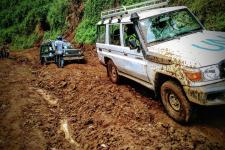Paths of authority, roads of resistance

Donors—the UN, World Bank, and others—try to stabilize eastern Congo not only by combatting rebels but also by building roads. They have poured millions of USD in road reconstruction projects, with the goal to help reestablish of state control, facilitate access to markets and promote security by weakening rebel control over isolated rural areas.
To be sure, the state of the road network in eastern Congo is very poor, and often decried by Congolese as the foremost challenge to development. But can transport infrastructure really lead to political stabilization?
The short answer is no, finds a new article for the journal Geoforum by DIIS researcher Peer Schouten together with Saidi Batundi and Janvier Murairi (of the Congolese Association for the Development of Peasant Initiatives) and Judith Verweijen (Sheffield University). The authors explore the ambiguous politics of infrastructure as a weapon for peace.
They do so by revisiting a seminal study on the politics of roads that the political ecologist James Fairhead conducted over three decades ago in the same area, when the country was still called Zaire. Schouten and his co-authors find that roads are still as central to political dynamics as they were 30 years ago, but have also become crucibles in violent struggles between rebels, soldiers, civilian and traditional authorities over the extraction of wealth from road users.
Their fieldwork showed that these ‘circulation struggles’ are only temporarily reshuffled because of roadworks; the overarching political economy of predation is left intact. This is in part because road rehabilitation projects are often of short duration, and in part because eastern Congo’s particular geomorphology—its soils are of a type that is fundamentally intractable to all but the most expensive type of road engineering.
Ultimately, eastern Congo’s road network challenges the dichotomy between state- and rebel control as well as the dichotomy between infrastructure and rough terrain. This leads the authors to challenge the deeply ingrained opposition of rough terrain as a space of resistance to spaces suffused with infrastructure as amenable to control—an opposition both central to theories of control and resistance and peace- and state-building interventions in so-called fragile states.
- The ambition to instill political order in Congo through infrastructural interventions dates back to the colonial period’, says Schouten.
- When the World Bank started pouring money into Congo’s transport infrastructure. Sixty years and billions of USD later, Congo still has the worst road network in the world, and the east is more insecure than ever. We suggest that perhaps these road projects serve another kind of political economy, one in which donor money disappears in the pockets of consultants and local politicians, without ever leading to development outcomes.
DIIS Experts

